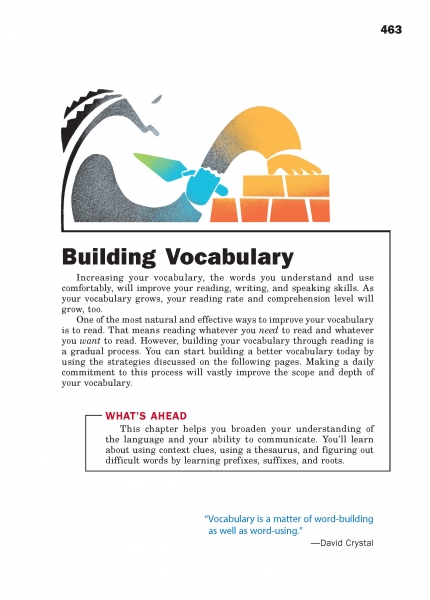Page 463 from

Start-Up Activity
Ask students what words they think are the oldest. They may suggest words such as "mammoth," "spear," "hunt," "cave," "man," "woman," and other terms related to prehistoric society. Share with them these ancient words:
-
I, we, two, three, five
According to scientists, those words predate English. They existed in basically that form for 20 times as long as English. They even predate civilization. The reason they have such staying power is that they describe very important and specific concepts and they are used constantly. Words that describe general concepts and/or are rarely used differ widely across cultures and do not survive very long. For example, Indo-European languages have 46 different ways to say "dirty," which means these forms will probably fall out of use.
Tell students this chapter takes a close look at all kinds of words, but especially the prefixes, suffixes, and roots that have been with English from before it was English. Learning them can unlock thousands of other words.
Think About It
“The word theatre comes from the Greeks. It means the ‘seeing place.’ It is the place people come to see the truth about life and the social situation.”
—Stella Adler

Start-Up Activity
Ask students what words they think are the oldest. They may suggest words such as "mammoth," "spear," "hunt," "cave," "man," "woman," and other terms related to prehistoric society. Share with them these ancient words:
-
I, we, two, three, five
According to scientists, those words predate English. They existed in basically that form for 20 times as long as English. They even predate civilization. The reason they have such staying power is that they describe very important and specific concepts and they are used constantly. Words that describe general concepts and/or are rarely used differ widely across cultures and do not survive very long. For example, Indo-European languages have 46 different ways to say "dirty," which means these forms will probably fall out of use.
Tell students this chapter takes a close look at all kinds of words, but especially the prefixes, suffixes, and roots that have been with English from before it was English. Learning them can unlock thousands of other words.
Think About It
“The word theatre comes from the Greeks. It means the ‘seeing place.’ It is the place people come to see the truth about life and the social situation.”
—Stella Adler



